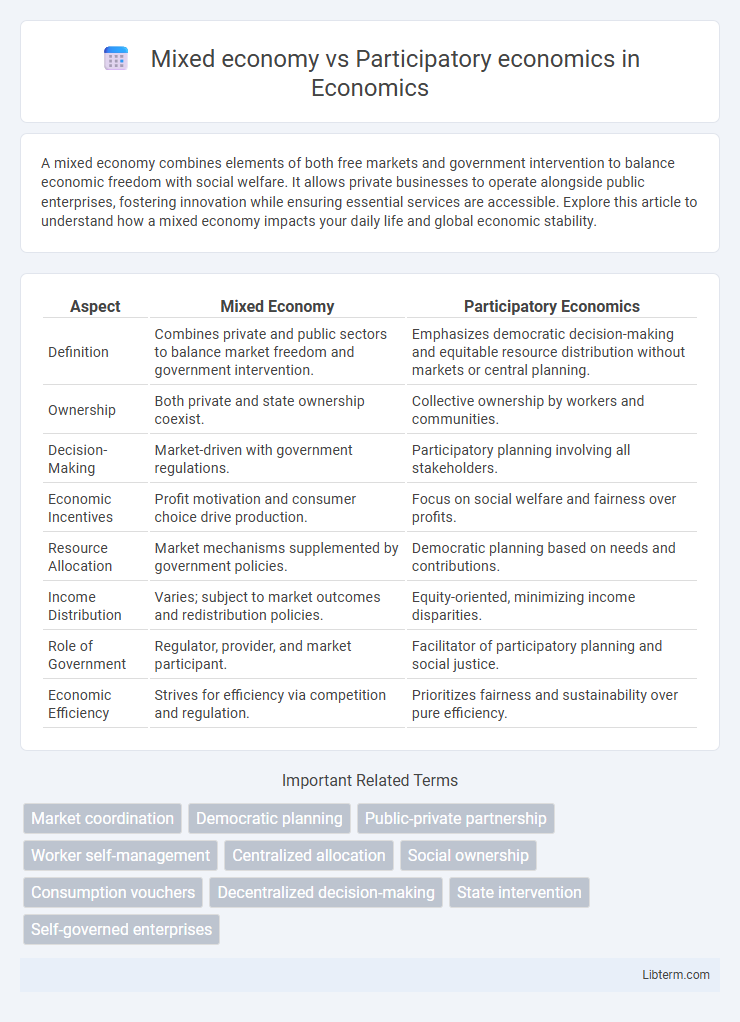A mixed economy combines elements of both free markets and government intervention to balance economic freedom with social welfare. It allows private businesses to operate alongside public enterprises, fostering innovation while ensuring essential services are accessible. Explore this article to understand how a mixed economy impacts your daily life and global economic stability.
Table of Comparison
| Aspect | Mixed Economy | Participatory Economics |
|---|---|---|
| Definition | Combines private and public sectors to balance market freedom and government intervention. | Emphasizes democratic decision-making and equitable resource distribution without markets or central planning. |
| Ownership | Both private and state ownership coexist. | Collective ownership by workers and communities. |
| Decision-Making | Market-driven with government regulations. | Participatory planning involving all stakeholders. |
| Economic Incentives | Profit motivation and consumer choice drive production. | Focus on social welfare and fairness over profits. |
| Resource Allocation | Market mechanisms supplemented by government policies. | Democratic planning based on needs and contributions. |
| Income Distribution | Varies; subject to market outcomes and redistribution policies. | Equity-oriented, minimizing income disparities. |
| Role of Government | Regulator, provider, and market participant. | Facilitator of participatory planning and social justice. |
| Economic Efficiency | Strives for efficiency via competition and regulation. | Prioritizes fairness and sustainability over pure efficiency. |
Introduction to Mixed and Participatory Economies
Mixed economies combine elements of both market and planned economies, allowing private enterprise alongside government intervention to balance efficiency and social welfare. Participatory economics, or parecon, emphasizes decentralized planning through worker and consumer councils, aiming for equitable distribution of resources without traditional market competition. Both systems seek to address economic fairness but differ fundamentally in decision-making processes and the role of markets.
Defining Mixed Economy
A mixed economy combines elements of both capitalism and socialism by allowing private enterprise alongside government intervention and regulation to balance market efficiency with social welfare. This system supports competitive markets while enabling state control over critical industries and public services to address inequality and provide economic stability. Unlike participatory economics, which emphasizes decentralized democratic control and equitable participation in economic decision-making, a mixed economy maintains a blend of public and private sector influences to drive growth and social goals.
Understanding Participatory Economics
Participatory economics emphasizes democratic decision-making through councils where workers and consumers collaboratively manage production and distribution, contrasting with mixed economies that combine market mechanisms and government intervention. It eliminates hierarchical structures by implementing balanced job complexes and remuneration based on effort and sacrifice, aiming to promote equity and self-management. The model proposes iterative planning processes to allocate resources efficiently while ensuring participatory input at every economic level.
Core Principles and Foundations
Mixed economy balances private enterprise and government intervention to promote economic efficiency and social welfare, emphasizing market mechanisms alongside public control in essential sectors. Participatory economics centers on democratic decision-making, equitable distribution, and decentralized planning, aiming to eliminate hierarchies through worker and consumer councils. Core principles of mixed economy include market regulation and welfare provision, while participatory economics prioritizes self-management, balanced job complexes, and remuneration based on effort and sacrifice.
Resource Allocation Mechanisms
Mixed economies allocate resources through both market forces and government interventions, balancing private enterprise with public policies to correct market failures and promote social welfare. Participatory economics utilizes decentralized planning and cooperative decision-making processes, where workers and consumers directly participate in allocating resources based on collective feedback and social cost assessments. Resource allocation in mixed economies relies on price signals and regulatory frameworks, whereas participatory economics emphasizes democratic participation and equitable distribution without traditional market pricing.
Role of Government and Public Involvement
In a mixed economy, the government plays a significant regulatory and interventionist role to balance free markets with social welfare, ensuring public goods provision and market corrections. Participatory economics emphasizes direct public involvement through workplace councils and participatory planning, minimizing hierarchical government control by empowering communities and workers to make economic decisions collectively. The government's role shifts from central authority to facilitating democratic participation and equitable resource allocation in participatory economics.
Decision-Making Structures
Mixed economies feature a dual decision-making structure where market forces drive consumer and business choices while government agencies regulate and intervene in key sectors to balance public welfare and economic efficiency. Participatory economics employs decentralized and democratic decision-making processes through workers' and consumers' councils, emphasizing collective deliberation and balanced job complexes to ensure equity and empowerment across all participants. This model replaces traditional hierarchical or market-driven authority with negotiated planning and participatory negotiation to optimize both production and distribution.
Addressing Inequality and Social Welfare
Mixed economies balance market-driven growth with government interventions, using progressive taxation and welfare programs to reduce inequality and promote social welfare. Participatory economics emphasizes decentralized decision-making and equitable resource allocation through worker and consumer councils, aiming to directly address disparities by empowering communities. Both systems seek social equity, but participatory economics prioritizes democratic participation and cooperative ownership for systemic change.
Economic Efficiency and Growth Potential
Mixed economies balance market mechanisms with government intervention, often achieving higher economic efficiency through resource allocation driven by supply and demand, which fosters stable growth potential by incentivizing innovation and investment. Participatory economics emphasizes cooperative decision-making and equitable resource distribution, potentially sacrificing some economic efficiency due to consensus-based planning, yet promoting sustainable growth by addressing social equity and reducing disparities. The growth potential in mixed economies typically outpaces participatory models due to dynamic market competition, while participatory economics prioritizes long-term societal well-being and resilience over rapid expansion.
Challenges and Future Prospects
Mixed economies face challenges such as balancing government intervention with market freedom, managing income inequality, and addressing environmental concerns while sustaining growth. Participatory economics encounters difficulties in implementing democratic decision-making at scale, ensuring efficiency without traditional market mechanisms, and overcoming resistance from entrenched economic interests. Future prospects for mixed economies involve integrating sustainable development policies and technological innovation, whereas participatory economics aims to expand through grassroots movements and digital platforms enhancing collective economic planning.
Mixed economy Infographic

 libterm.com
libterm.com